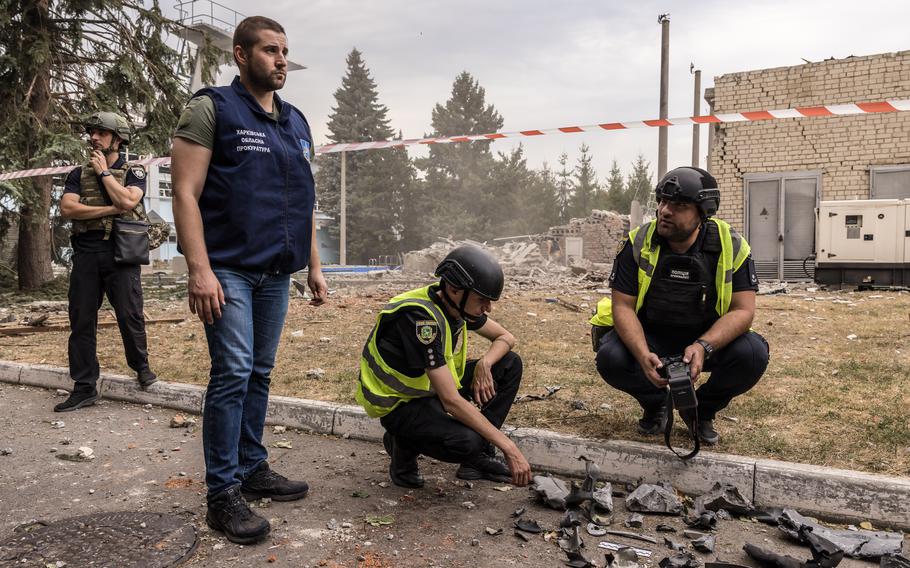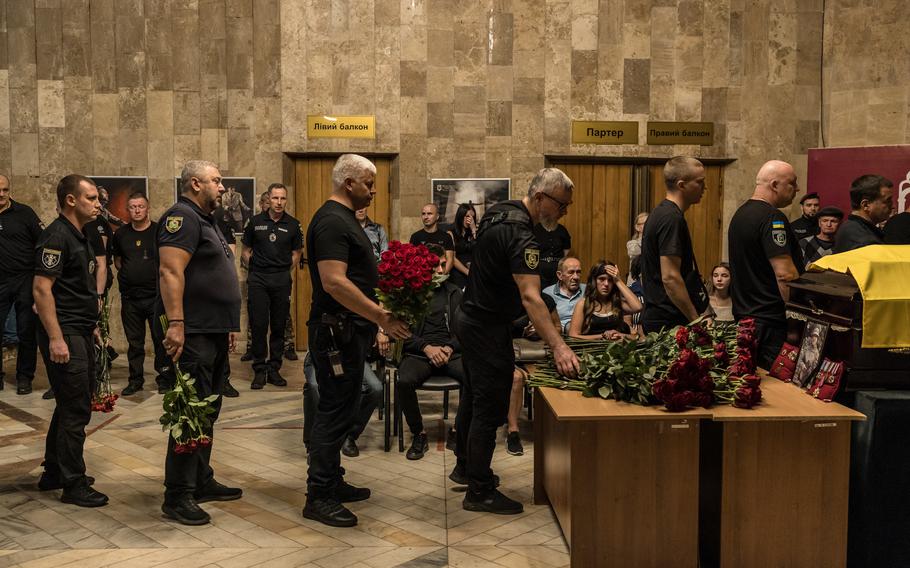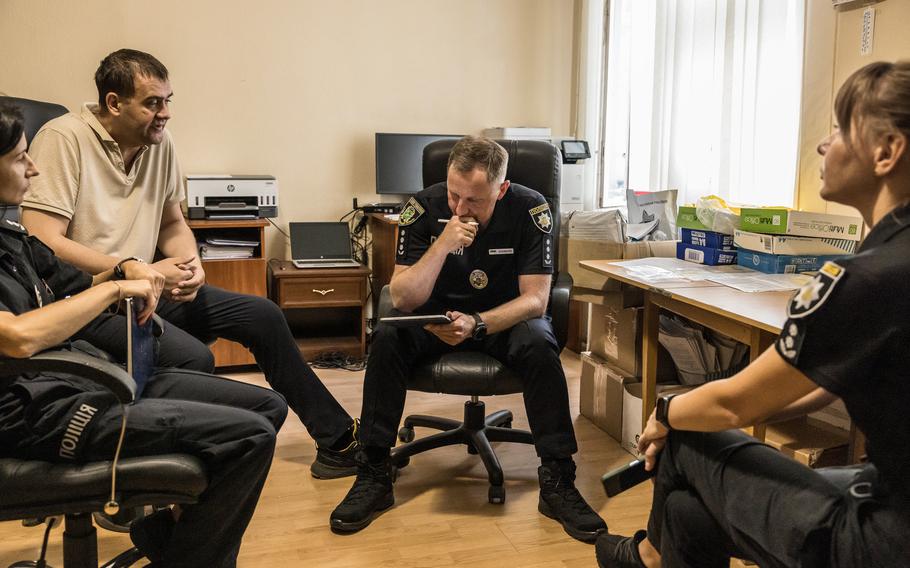Europe
When Russian bombs fall on Kharkiv, this man collects the evidence
The Washington Post September 17, 2024

Police and prosecutorial staff on Sept. 2 collect bomb fragments as evidence of a Russian glide bomb strike. (Oksana Parafeniuk for The Washington Post)
KHARKIV, Ukraine — The video footage is graphic, but Serhii Bolvinov doesn’t care. He believes the world needs to see what’s happening in Ukraine to stop the terror raining over his city.
He uploads it to his Facebook page and posts it on Twitter.
It’s early September. Days earlier, on Aug. 30, glide bombs slashed the skies above Kharkiv — just 20 miles from Russia — and pummeled a house, a sports field, a warehouse, an apartment building, a city park. In a 1 minute and 20-second video, Bolvinov flips through scenes of destruction.
It’s gruesome. It’s his reality.
In the past 2½ years, Bolvinov — head of investigations for the national police in the Kharkiv region — has looked into the death of every civilian in this corner of northeast Ukraine. Killed by missiles and drones. Buried under rubble. Exhumed from mass graves. All 2,678 of them, including 93 children.
He and his team gather the broken bits of bodies. They measure the shrapnel and collect the missiles in a special graveyard. They build their cases. Bolvinov knows the culprit. But how — and whether — Russian officials and troops will ever be held accountable for their war crimes is unclear.
The investigator isn’t waiting for that day to arrive. In his video from Aug. 30, he presents more of his evidence: Flames lick a 12-story apartment building, set ablaze by a glide bomb. A woman is trapped on the top floor, waving from her kitchen, unreachable as her apartment burns. On the lawn, a rug stitched with roses covers the body of a victim, feet jutting out the bottom.
The scene shifts. A few miles away, a city park is in summer’s last bloom. A 14-year-old girl slumps on a bench. The ground around her is cratered by shrapnel. Her head is blurred, pixelated in shades of red, some things too unspeakable to show. She is wearing all white, down to her New Balance sneakers. One day in Kharkiv: 97 people wounded, six dead.
“Every death and every destruction is our pain,” Bolvinov writes, captioning the video.
He can’t look away from the carnage. He doesn’t think you should either.
‘A great sorrow’
The air attack alarms here are constant. In August, they blared for 369 hours and 31 minutes — or almost 16 straight days. People have grown used to the danger of living this close to Russia. Couples walk hand-in-hand in the park, even as their phones shriek out a warning. Apartment buildings sport plywood windows. Children attend school underground.
Bolvinov could have left it all behind.
The 42-year-old was appointed lead investigator for Kharkiv in December 2021. Two months later, Russians invaded, threatening to take control of the city before Ukrainian troops beat them back. Bolvinov could have fled with his family. Unlike most Ukrainian men banned from traveling abroad under martial law, he has three children under 18 — and the right to leave with them.
Instead, he sent his family away. The last time they were all together was in January.
Kharkiv is his life; it’s where he was born, raised, educated, married and has worked. He refuses to leave his post — even when his memories are blown to smithereens and overwritten with pain. A missile hit his police building. Nine people died. A glide bomb hit the apartment building where he lived as a student. Four more deaths.
For his work investigating war crimes, Russia listed him as a war criminal — an irony that is not lost on him — and released his personal information, including his cellphone number, his parents’ address, his birthday.
He stopped speaking Russian. He started meditating. And worked harder.
His experience is not unique. He oversees almost 1,000 officers who bear witness to the unimaginable, filling servers with terabytes of information they hope will someday be used in legal cases against Russian perpetrators. They investigate only civilian deaths — innocent people caught in Russia’s crosshairs, far from the front lines.
Their work is constant.

Colleagues lay flowers at the funeral of senior police inspector Oleksandr Popovych, 44, on Sept. 3, 2024. Popovych was hit by a drone while sitting in his police car. (Oksana Parafeniuk for The Washington Post)
Point of impact
At Yuryeva Park, Bolvinov walks the path of the blast. It has been three days since the glide bombs hit on Aug. 30. He wants to show a reporter what he saw that afternoon when two people died.
He knows that numbers can feel abstract, but these fatalities — like all the others — are more than figures to him. They represent people with hopes and dreams. Here, the victims were young, at the beginning of their lives. His job is to help avenge their violent end.
He walks past a bench near the playground. A boy is pushing a yellow dump truck in the sandbox.
“We are now standing at the point of impact,” Bolvinov says. “A half-ton, highly explosive aerial bomb. This is a bomb that is used to destroy buildings.”
It dropped from the sky at 3:20 p.m. In its path was 18-year-old Veronika Kozhushko, or “Nika” to friends. An artist and poet, she was waiflike and gentle, with bobbed hair. She made sense of the war in sketches — a ruined apartment building in blue ink, ghostlike figures superimposed in white. Two buildings tattooed on an arm, the windows bleeding red.
“She would speak quickly, as if she was running out of time to finish her sentences,” said her friend Maryna Grachova, who works at the Kharkiv museum where Nika volunteered. “She wanted to put as much in her time as she could.”
That afternoon, she’d been mailing a package.
Bolvinov keeps walking. He points at a golfball-sized hole wrenched through a metal swing set, at the bark shaved off the maples.
“You can see that the trees still bear the marks of the bomb,” he says. “Forty-one people were injured. Some lost limbs. Now let’s walk the trajectory of the shrapnel.”
He walks toward a bench lined with flowers and stuffed animals. This was where the other victim, 14-year-old Sofia Hlyniana, was sitting. Dressed in all white, taking photos with a friend at sunset. A moment of ease after so much loss — fleeing her hometown of
Kupyansk, learning her father was missing in action in the Donetsk region. Still, she tried to be strong for her mother and younger sister.
“Sofia was constantly in movement,” said Natalya Lysenko, a family friend. “She would draw and ride horses and write poetry that she didn’t want to read out loud. She was shy.”
She had recently decided to become a psychologist to help others.
“Every day Russia takes someone’s life,” Bolvinov says. “The life of 14-year-old Sofia or 18-year-old Veronika. In a normal world, we do not have to collect the bodies of girls in parts.”
Bolvinov gestures at the bench, where Sofia’s backpack had been. Her cellphone was inside, a dozen missed calls on the screen. An officer used it to call her mother.

Bolvinov meets with colleagues from the forensics department in Kharkiv on Sept. 3, 2024. (Oksana Parafeniuk for The Washington Post)
A funeral, a siren
The next day begins with a funeral. Bolvinov’s colleague was hit by a drone in his police car. Now, Bolvinov stands with other officers near the open casket, holding a cluster of red roses, the stems duct-taped together. Music plays softly on a speaker. The officer’s mother cries.
Bolvinov knows that Russian weapons leave damage that can’t be easily captured as evidence, rupturing the lives of those left behind — forced to make sense of a war they didn’t want, to feel around the hole left by their loved one’s absence.
It never gets easier.
“We’re all victims,” he says later.
The casket hadn’t yet been loaded into the hearse — which would take the officer to the same cemetery as 14-year-old Sofia - but Bolvinov has to get back to work.
The air attack alarm sounds. Another missile in the air.
Oksana Parafeniuk contributed to this report.